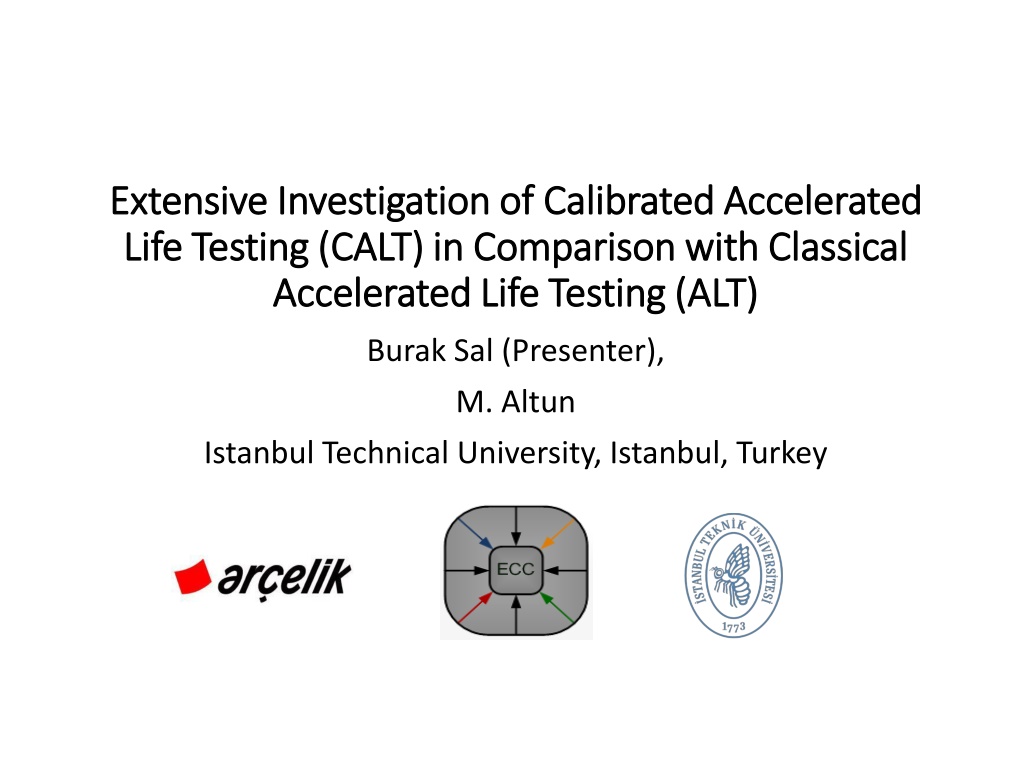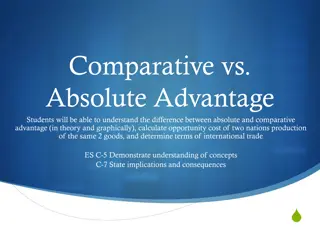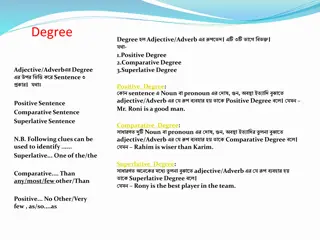Comparative Analysis of ALT and CALT Methods in Accelerated Life Testing
This study presents an extensive investigation comparing Calibrated Accelerated Life Testing (CALT) with Classical Accelerated Life Testing (ALT) methods. It explores the use of 6 samples in CALT versus 100 samples in ALT, emphasizing the advantages of CALT in terms of sample size and efficiency. The research delves into the test mechanisms, performance parameters, and case studies of both methods, offering insights into their accuracy and efficacy. Additionally, it discusses the definitions, general test mechanisms, life-stress plots, and performance parameters involved in ALT and CALT. Through detailed analysis and comparative studies, this work provides a comprehensive understanding of utilizing ALT and CALT in accelerated life testing scenarios.
Download Presentation

Please find below an Image/Link to download the presentation.
The content on the website is provided AS IS for your information and personal use only. It may not be sold, licensed, or shared on other websites without obtaining consent from the author. Download presentation by click this link. If you encounter any issues during the download, it is possible that the publisher has removed the file from their server.
E N D
Presentation Transcript
Extensive Investigation of Calibrated Accelerated Extensive Investigation of Calibrated Accelerated Life Testing (CALT) in Comparison with Classical Life Testing (CALT) in Comparison with Classical Accelerated Life Testing (ALT) Accelerated Life Testing (ALT) Burak Sal (Presenter), M. Altun Istanbul Technical University, Istanbul, Turkey
Motivation CALT uses 6 samples ALT uses 100 samples WHICH ONE DO YOU CHOOSE ? Is it though? Is it though? 6 samples < 100 samples So choosing CALT will be the best way ever!!!! Is it though? Is it though? What about the time that CALT has to run until the sample fails? What about the accuracy?
OUTLINE Introduction Definition of ALT and CALT General Test Mechanism Life-Stress Plot of CALT Performance Parameters Bounds Ratio Calculation of Performance Parameters Comparison of ALT and CALT with changing performance parameters Failure Rate Comparison Acceleration Factor Comparison Case Studies Threshold Values of ALT and CALT Case Studies Case Study - 1 Case Study - 2 Case Study - 3 Conclusion
Definiton of ALT and CALT Accelerated Life Testing (ALT) and Calibrated Accelerated Life Testing (CALT) are mainly used test methods. Also Highly Accelerated Life Testing (HALT) is used before these testing methods to determine absurd stress levels. ALT uses analytical equations to determine test stress level and sample size. CALT uses profile methods for stress levels and 2 sample size for each profile. Each profile is %10 reduced version of previous level.
General Test Mechanism HALT CALT ALT Analytical Calculations 2. Profile 1. Profile (%10 Reduced of HALT) 3. Profile (%10 Reduced of 1. Profile) (%10 Reduced of 2. Profile)
Life-Stress Plot of CALT CALT s Life-Stress plot is controversial because of few stress points are determined.
Performance Parameters Bounds Ratio Bounds Ratio affects accuracy with failure rate and sample size.
Calculation of Parameters - ALT Reliability, R(t)= exp(-WT/MTTF) R(t)= exp(-t/n )^ = Beta, n= Eta, t= WT (hours) AF=exp[(Ea/k)*(1/Tfield-1/Ttest)] Ea= Activation Energy, Tfield= Field Temperature, Ttest= Test Temperature, n1 /AF= n2 P1= 1-exp(-t/n1)^ , P2= 1-exp(-t/n2)^ P1 and P2 Probability of Failure values, t= Estimated Time (hours), k= Boltzmann constant
Calculation of Parameters - ALT Bounds Ratio= Upper Limit/Lower Limit lnTp+ z*std(lnTp)= Upper Limit lnTp- z*std(lnTp)= Lower Limit Tp= Standard Deviation, z= Normal Distribution Parameter. Sample Size= (z*A*BR)^c A= Average variance coefficient, c= Distribution Parameter. Unit Test Time= (Normal Yearly Time*Warranty Time)/AF Total Test Time= Sample Size Unit Test Time
Calculation of Parameters - CALT Sample Size= 6 Recommended sample size for CALT is 6, however, sample size can be increased in order to increase accuracy. Unit Test Time= (Normal Yearly Time*MTTF)/AF Total Test Time= Sample Size Unit Test Time
Comparison of ALT and CALT Failure Rate We have compared FR (%10, %1, %0.1) and accuracy levels of ALT and CALT by the changing of WT and MTTF. calt alt alt alt calt calt
Accuracy Comparison with Failure Rate levels Accuracy Comparison FR=%1, MTTF=30 years, WT=3 Years. Accuracy Comparison FR=%0.1, MTTF=30 Years, WT=3 Years. ALT Accuracy Comparison FR=%10, MTTF=30 years, WT=3 Years. ALT CALT CALT ALT CALT %100 %14 %100 %97 %100 %50 Accuracy Comparison FR=%1, MTTF=30 Years, WT= 1 year. ALT Accuracy Comparison FR=%10, MTTF=30 Years, WT= 1 year. ALT Accuracy Comparison FR=%0.1, MTTF=30 Years, WT= 1 year. ALT CALT CALT CALT %100 %70 %100 %98 %100 %45 Accuracy Comparison FR=%0.1, MTTF=10 Years, WT= 1 year. Accuracy Comparison FR=%10, MTTF=10 Years, WT= 1 year. ALT Accuracy Comparison FR=%1, MTTF=10 Years, WT= 1 year. ALT CALT ALT CALT CALT %100 %84 %100 %62 %100 %99
Comparison of ALT and CALT Acceleration Factor We have compared AF (10, 20, 30) and accuracy levels of ALT and CALT by the changing of FR. alt alt calt calt calt alt
Accuracy Comparison with Acceleration Factor levels Accuracy Comparison FR=%1, MTTF=30 years, WT=3 Years. AF=10 Accuracy Comparison FR=%10, MTTF=30 years, WT=3 Years, AF=10 Accuracy Comparison FR=%0.1, MTTF=30 Years, WT=3 Years. AF=10 ALT ALT CALT ALT CALT CALT %100 %97 %100 %50 %100 %14 Accuracy Comparison FR=%10, MTTF=30 Years, WT= 1 year, AF=20 Accuracy Comparison FR=%1, MTTF=30 Years, WT= 1 year, AF=20 ALT Accuracy Comparison FR=%0.1, MTTF=30 Years, WT= 1 year, AF=20 ALT CALT CALT ALT CALT %100 %100 %100 %97 %100 %50 Accuracy Comparison FR=%10, MTTF=10 Years, WT= 1 year, AF=30 ALT Accuracy Comparison FR=%0.1, MTTF=10 Years, WT= 1 year, AF=30 ALT Accuracy Comparison FR=%1, MTTF=100 Years, WT= 1 year, AF=30 ALT CALT CALT CALT %100 %100 %100 %72 %100 %98
Threshold Values for ALT and CALT Usage ALT and CALT can not be used under these values. TfW=10 hours AF ALT CALT 10 180 hours 1750 hours 20 90 hours 900 hours 30 70 hours 465 hours TfW=30 hours AF ALT CALT 10 54 hours 525 hours 20 27 hours 270 hours 30 21 hours 140 hours
Case Study - 1 We determined wanted input values and chose one of the test methods. Input Values ALT CALT AF=10 MTTF=30 years WT=3 years BR= 5 TT= 1000 hours TfW= 10 hours FR=%9.5 SS=11 Accuracy=%9 TT=1000 hours CAN NOT BE USED. (IT IS UNDER THE THRESHOLD VALUE)
Case Study - 2 We determined wanted input values and chose one of the test methods. Input Values ALT CALT AF=20 MTTF=30 years WT=3 years BR= 5 TT= 1000 hours TfW= 3 hours FR=%9.5 SS=20 Accuracy=%100 TT=652 hours FR=%9.5 SS=5 Accuracy=%98 TT=1000 hours
Case Study - 3 We determined wanted input values and chose one of the test methods. Input Values ALT CALT AF=20 MTTF=30 years WT=3 years BR= 5 TT= 500 hours TfW= 3 hours FR=%9.5 SS=15 Accuracy=%76 TT=500 hours FR=%9.5 SS=3 Accuracy=%41 TT=500 hours
Conclusion We show that even though CALT uses fewer sample size than ALT, its accuracy and total test time can not beat ALT in some levels. Also, we support that result with parameter calculations, graphs and case studies. Our future work will be Dynamic Test Method which can be used with one by one sample and performance parameter will change to arrange wanted test results.
Thank you for listening Any Questions? Info: salb@itu.edu.tr























